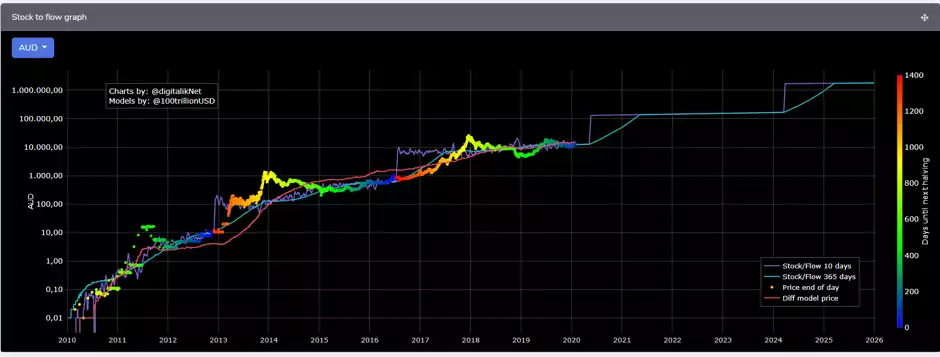Stock-To-Flow Forecast Holds – Predicts $100K Bitcoin with Halving
News
|
Posted 30/01/2020
|
14314
Stock-to-Flow measures a commodity’s price using two factors: the stock — the amount in circulation — and the flow, which is the amount entering circulation. Bitcoin's low emission rate relative to its existing supply, like gold, means Stock-to-Flow constitutes useful evidence in the argument that Bitcoin is "digital gold."
This model treats Bitcoin as being comparable to commodities such as gold, silver or platinum. These are known as 'store of value' commodities because they retain value over long time frames due to their relative scarcity. It is difficult to significantly increase their supply i.e. the process of searching for gold and then mining it is expensive and takes time. Bitcoin is similar because it is also scarce. It is the first-ever scarce digital object to exist. There are a limited number of coins in existence and it will take a lot of electricity and computing effort to mine the 3 million (of end total 21m) outstanding coins still to be mined, therefore the supply rate is consistently low.
Stock-to-flow ratios are used to evaluate the current stock of a commodity (total amount currently available) against the flow of new production (amount mined that specific year).
For a store of value commodities like gold, platinum, or silver, a high ratio indicates that they are mostly not consumed in industrial applications. Instead, the majority is stored as a monetary hedge, thus driving up the stock-to-flow ratio. A higher ratio indicates that the commodity is increasingly scarce - and therefore more valuable as a store of value.
Halving events will continue taking place until the reward for miners reaches 0 BTC. Since Bitcoin's value representation has 8 decimal places, after the 33rd halving, the value of the reward will hit precisely 0 BTC. 33 halving events every 4 years adds up to 132 years total. The last Bitcoin to be mined into existence will be mined in the year 2140. It will be the 21 millionth Bitcoin to come into existence, and last, after which point it will be impossible to create anymore. From then on, Bitcoin will become truly 'deflationary', since mining new coins will no longer be possible, and if owners keep on losing their private keys, as they currently are, then the supply would further deflate by that lost-keys ratio. It is not possible to copy or forge Bitcoins, and the total supply is strictly limited. All transactions are written in blocks, and nobody can spend coins that belong to someone else's bitcoin address. That is where "scarcity" comes into play. The dictionary definition of scarcity is when something is difficult to come across in nature or the lab; very similar to precious metals. Once something becomes scarce enough, it can be used as money. Stock to flow is defined as a relationship between production and current stock that is out there.

On the above chart, price is overlaid on top of the stock-to-flow ratio line (note the logarithmic vertical scale). We can see that price has continued to follow the stock-to-flow of Bitcoin over time. The theory, therefore, suggests that we can project where price may go by observing the projected stock-to-flow line, which can be calculated as we know the approximate mining schedule of future Bitcoin mining.
The coloured dots on the price line of this chart show the number of days until the next Bitcoin halving (sometimes called 'halving') event. This is an event where the reward for mining new blocks is halved, meaning miners receive 50% fewer bitcoins for verifying transactions. Bitcoin halvings are scheduled to occur every 210,000 blocks – roughly every four years – until the maximum supply of 21 million bitcoins has been generated by the network. That makes stock-to-flow ratio (scarcity) higher so in theory price should go up. This has held previously in Bitcoin's history.
The stock-to-flow line on this chart incorporates a 365-day average into the model to smooth out the changes caused in the market by the halving events.
Stock-to-Flow’s creator known as PlanB originally suggested that Bitcoin would hover at an average before its block reward halving in May 2020.
At that point, a 50% reduction in the number of new Bitcoins released to miners each block would further limit the flow versus the existing stock. Thereafter, he has said, price-performance should accelerate dramatically — by 2022, a single Bitcoin should be worth around $100,000.